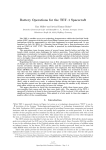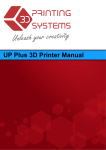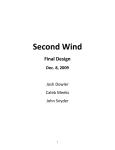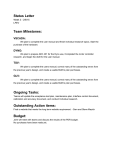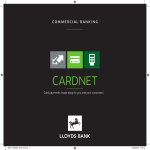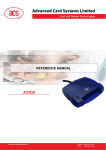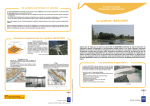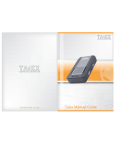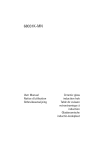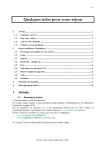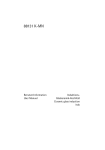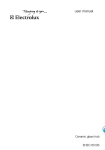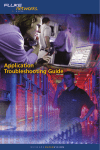Download BasicCards 101 (Part 2)
Transcript
Circuit Cellar, the Magazine for Computer Applications. Reprinted by permission. For subscription information, call (860) 875-2199, or www.circuitcellar.com. Entire contents copyright ©2001 Circuit Cellar Inc. All rights reserved. FEATURE ARTICLE by Brian Millier BasicCards 101 (Part 2) Use in a Liquid Nitrogen Monitor Now that you’re familiar with ZeitControl’s BasicCard, it’s time to take a closer look at the process of programming one and incorporating it in a design. Brian shows you how he integrated BasicCard technology in the design of a liquid nitrogen generator. L ast month, I introduced you to liquid nitrogen flow for a long enough CIRCUIT DETAILS ZeitControl’s BasicCard, which is a period to dispense the necessary Because the prototype would be the smartcard that is programmed in amount of LN2. only unit I would need, I wanted to BASIC. In Part 2, I’d like to further use a commercial development board Periodically, the BasicCards are colexplore the programming of these and just add the few custom parts lected and another PC application is run cards and discuss a project. needed for the design. I chose the that zeroes out the accumulated LN2 I built a device that allows you to Futurlec 8535 development PCB total. It transfers that figure to a table use BasicCards like debit cards to conbecause it’s inexpensive, contains that is used for the actual billing process. trol the dispensing of liquid from a liqheaders for commonly used peripherIn the past, an honor system was uid nitrogen generator/storage tank. als, and has a large enough prototype used in which users entered their The idea is to issue each liquid nitroarea to mount the few extra compoLN2 usage on a sign-out sheet posted gen user here at Dalhousie University nents I needed to complete the design. next to the generator. We lost some with a BasicCard. Each card is personFigure 1 is a diagram of the circuit. LN2 billings here at the university alized by entering the user’s name, Some of the circuitry on the Futerlec because of dishonesty and low-ball account number, and a zero balance. estimates of the actual amounts board that is not required for this project Card personalization is done on a PC taken. Also, there was a significant is not shown in the diagram. For examusing a Windows-based application. amount of clerical time spent tallyple, the in-circuit serial programming This user-friendly application intering all of the entries on the daily port for the 8535’s flash program memofaces to the BasicCard using the sign-up sheets. ry is not shown. There is one small CyberMouse reader that comes change that I had to make to the with the development kit. Futurlec board itself. The board To access some liquid nitrocomes fitted with an 8-MHz gen (LN2), insert your BasicCard MCU clock crystal. I changed that to 3.579 MHz so that I into the custom controller concould use a common clock for nected to the LN2 generator. both the MCU and BasicCard, The controller checks to ensure which has a 5-MHz maximum that the card is properly personclock rate and communicates alized for this use, and displays at 9600 bps when clocked at your name, account number, 3.579 MHz. and the number of liters of LN2 I mounted an Amphenol previously consumed during the C702 10M0008 2834 smartcard current billing period. You then socket in the prototype area of enter the amount of LN2 desired the PCB. This socket contains on the controller’s keypad. After an NC switch that opens up updating the BasicCard EEPwhen a card is inserted, makROM variable, which stores ing it easy for the MCU to the accumulated LN2 usage, know when to establish comthe controller activates a relay Photo 1—Check out the monitor before it’s mounted in its cabinet. Note the BasicCard sticking out of the card socket on the right-hand side. munications with the card. that opens a valve and lets the 24 Issue 165 April 2004 CIRCUIT CELLAR® www.circuitcellar.com Although I connected this line to port activate the dispensing valve. This was Atmel’s AT90S8535 is a versatile D3 of the ’8535 (INT1), I don’t use this a solenoid valve that required 120 VAC MCU. In some respects it is overkill pin as an interrupt input, instead I to operate, so I decided to use a relay to for this application. With the program poll the pin to see when a card is either keep any inductive kickback from its written in compiled BASIC, much of inserted or removed. There are a few coil away from the MCU circuitry. Any its 8-KB flash program memory is different phases in the program, and relay with a 12-V coil and contacts able unused. It contains 512 bytes of EEPthe removal of a card must be handled to switch 1-A AC will do for K1. If the ROM, which is unused apart from a differently in each case, so using an coil needs more than a few hundred few bytes used to store some valve interrupt to signal card-in-socket status milliamps to operate, you’ll need a largtime calibration parameters. The eightwas not ideal for this project. er transistor than a 2N3904 for Q1. channel ADC, UART, and SPI funcThe BasicCard interfaces to the ’8535 Diode D1 is placed across the relay coil tions weren’t needed either. However, using only two port lines. The *RESET to protect Q1 from the spike that the assembled Futurlec development input to the BasicCard is connected to occurs when the relay turns off. board, including the ’8535 MCU and port D2, and the I/O line connects to The 5-V power supply regulator is programmer cable, cost less than $30, port D4. As I mentioned earlier, the contained on the Futurlec PCB, but so I thought it made a lot of sense to BasicCard gets its clock signal directly the power transformer, bridge, and fildo things this way. from the ’8535’s XTAL1 pin, which is ter capacitor are mounted externally. its oscillator buffer output. Although Photo 1 shows the development board INTERFACE TO THE AVR MCU you have to be careful tapping off a with the extra components needed for Before I ordered the BasicCard clock signal from an MCU’s oscillator this project. development kit, I wanted to be sure I output, the BasicCard presents, in this The development board comes with a could use the cards with my MCU of case, such a small load that the oscillaMAX232 for RS-232 communications choice, the AVR series from Atmel. tor is unaffected by its presence. purposes. Although I did not use this The BasicCard development kit contains software to program the cards The user interface is the standard key- feature, it would be easy to wire the controller to a remote PC, for example, themselves, as well as a few different pad/LCD. I had a Grayhill series 88 keyif you want to log all the transactions programs to develop PC applications. pad on hand, which contains the numin real time to a computer file. However, the kit doesn’t provide any bers in a telephone-like arrangement, as well as several extra keys labeled Enter, Clear, etc. that provide all the necessary input functions. Eight lines are needed to interface this Matrix keypad, and I used port A for that purpose. Doing so meant I could not make use of the eight-channel ADC contained in the ’8535, but I didn’t need an ADC for this project. The Futurlec board has a 10-pin header connected to this port, which made it easy to connect the keypad using a ribbon cable. I didn’t need a large LCD, because there isn’t a lot of information to display. Therefore, I used a 2 × 16 display, and connected it to the ’8535 in 4-bit mode using six lines of port C. The Futurlec board also provides a 14-pin header for the LCD, with all the signal and power wiring taken care of, as well as POT1 for contrast adjustment. Apart from wiring a few lines to the smartcard socket, all the circuitry I needed to add Figure 1—The liquid nitrogen dispensing monitor was built on a Futurlec 8535 development board. Apart from the card socket, was the driver and relay to keypad/LCD, and relay driver, most of the circuitry already exists on the development board. www.circuitcellar.com CIRCUIT CELLAR® Issue 165 April 2004 25 Command Name Description Used by PersonalizeCard IncreaseAmount GetCardData CancelLastTransaction ReadLastTransaction PRDisplay Initial card with name, account number, and balance Increase balance by amount dispensed Read name, account number, and balance Self-explanatory Needed by previous command Display information on key fob balance reader PC AVR AVR and PC AVR AVR Balance reader Table 1—These six commands are implemented in the BasicCard for this application. As you can see, some commands are used by both the LN2 dispensing controller and the PC application that personalizes and reads the cards. support for interfacing them to MCUs, apart from providing a technical reference document describing the ISO/IEC 7816-3 standard that the cards use for communication. From what I could see, it would have been quite time-consuming to personally write a suitable driver to allow AVR MCUs to talk to BasicCards. As luck would have it, the developer of the BASCOM AVR compiler (the language I use exclusively for all of my AVR-based projects) had a beta version of a driver library available. This was one of those good news/bad news situations. I was able to get the library free from the developer, but I was, at that time, the first and only beta tester! I ended up figuring out on my own some of the patches needed to make it work. To interface a BasicCard to an AVR MCU using the BASCOM compiler, you must run BASCOM version 1.11.6.8 or newer. You must also load the BasicCard library (available from MCS) into BASCOM’s LIB folder. Next, within your BASCOM program, you must do the following four things. First, use the CONFIG BCCARD command to tell the driver which port pins you have connected your BasicCard socket to. This is simple because you only have to tell it which port you are using and to which pins the *RESET and I/O lines are connected. This is clearly described in the documentation that comes with the library. Second, you must declare each of your BasicCard commands to the BASCOM program using the BCDEF command. Because you have already written the BASIC code that runs in the BasicCard, you will have already defined the commands that the BasicCard recognizes. These command names, followed by their parameter lists, are used with the BCDEF command. Next, instruct the compiler to use 26 Issue 165 April 2004 CIRCUIT CELLAR® the proper data rate. Use the $BAUD = 9600 and the $Crystal = 3579000 directives. Finally, issue a BCRESET command to initialize the BasicCard as soon as you see that a card has been inserted into the card socket. After this preparation/initialization, all you have to do to access a particular command in the BasicCard is use the BCCALL procedure. This is similar to any BASIC procedure, except that it includes some BasicCard-specific parameters. The following is the syntax for this command: BCCALL name( nad , cla, ins, p1, p2 [param1 , paramn]) where name is the name of the procedure in the BasicCard to call. It must be defined first with BCDEF. The name used with BCDEF and BCCALL does not need to be the same as the procedure in the BasicCard, because the CLA and INS bytes actually tell the BasicCard which command to execute. However, it makes sense to use the same names for consistency. nad is the node address byte. BasicCards respond to all node address values; zero is used here as a default. cla is the class byte. It is the first of a 2-byte CLA-INS command. It must match the value you used for the command in the BasicCard program itself. ins is the instruction byte. It is the second of the 2-byte CLA-INS command. The same consideration applies as for the CLA byte. p1 is parameter 1 of the CLA–INS header. (Use a zero for your purposes.) p2 is parameter 2 of CLA-INS header. (Again, use a zero for your purposes.) param1 through paramn are the parameters you want to pass to the BasicCard (as required by the command). The BasicCard operating system www.circuitcellar.com employs a comprehensive errorBasicCard, and the user inforreporting scheme. This is necesmation contained in the card is sary in any device used for comdisplayed on the LCD. You are merce, particularly in a device then prompted to enter the that you can pull out of its sockamount of LN2 needed. This et in the middle of program exeamount is first added to the cution! Describing the error BasicCard’s balance variable, handling is beyond the scope of and then the program waits this article, but I will mention until you indicate you’re ready that the BCCARD library supfor the dispensing to start. It ports it to some extent. In then activates the relay for the essence, if the BasicCard returns amount of time necessary to an error, the library will set the dispense the necessary LN2. BASIC variable ERR and two staThis is where calibration is tus bytes—SW1 and SW2—will needed. When dispensing LN2, contain error codes. Many of it takes a little while for the these codes are predefined in the transfer tube to become chilled Photo 2—This is a screen shot of the PC application that initially personBasicCard protocol, but you can enough to pass the liquid. alizes the BasicCard and reads out its balance periodically. also set the value of these variThereafter, the liquid flows ables yourself within your steadily, with the amount disBasicCard program should your code pensed being proportional to the time The PersonalizeCard command, encounter an error condition. the valve remains open. After this which the PC application uses to iniIn most designs, the card-in-socket amount of time, the program waits tialize the card with user information switch will notify the program if the until the card is removed, and then and zero out the balance, is the only card is removed during use; but, if an goes back to the start of the loop. command that requires encryption in actual data transaction is in progress Calibration involves determining the order to work. This guards against the when this happens, the BasicCard initial chill time and the time/liter possibility of fraudulent card producdriver within BASCOM may hang parameters empirically, and storing tion. ZeitControl’s Visual Basic API, the program until a time-out interval them as calibration parameters. which is part of the development kit It’s important that this calibration software, includes support for encryppasses. Depending on a number of can be done in a way that’s both contion. This command is only used by variables, this might take up to a venient for the operator of the generathe PC program that personalizes the minute, so beware of this during tor and secure from tampering. To that cards, and that is written in Visual debugging. end, I designed the program so that Basic. Although not a concern in this Before trying your own Basic-Card when it sees a card with an account application, the fact that the BASprogram, I recommend that you load number equal to zero (the operator COM AVR BasicCard library does not the sample Bccard.bas program into account), it goes into a calibration roucurrently support encryption could be your AVR MCU, program a BasicCard tine and prompts the operator for an a disadvantage in other applications. with the Calc demo program provided initial (transfer tube chilling) time, as For this application I used the with the development kit, and try that well as the number of seconds required BasicCard ZC3.9 enhanced card, combination. If everything is satisfacto transfer 1 liter of LN2. These parambecause it was included with the tory, you will see the results of the development kit. However, the lesser communication between the two eters are subsequently saved to EEPmodels of the card would work as well devices. You can then enter some ROM in the ’8535 and used in all because this is a simple application. In numbers into your AVR MCU, and let future liquid transfers, unless the calithe first part of this series I gave you the BasicCard act as a calculator. bration is changed. some hints on how to program the If you remove the card before enterBasicCards by supplementing the ing the desired number of liters to CARD FIRMWARE instructions in the user manual. dispense, the LCD indicates that the Table 1 shows a list of the commands card has been removed prematurely that I’ve defined in the BasicCard for and returns to the start of the loop. this application. The last column in AVR FIRMWARE this table indicates where the comNext, I’ll describe the program that mand is used: The LN2 Dispenser is runs on the ’8535, which controls the CARD ISSUER PROGRAM LN2 dispenser. After some initialization labeled “AVR.” The PC application Photo 2 shows a screen capture of personalizes the card and later reads of the ports, the program basically the Visual Basic Card Issuer applicathe accumulated total usage (labeled enters a loop. The program prompts tion. This program is run on a secure “PC”). The balance reader is the little you to insert the card and then waits PC because it is used to personalize key fob device that comes with the for this to happen. The ReadCardData the BasicCard with the username and development kit. command is then issued to the account number, and to set the initial www.circuitcellar.com CIRCUIT CELLAR® Issue 165 April 2004 27 balance variable to zero. Obviously, anyone with access to this program can insert their card and wipe out its balance easily. After start-up, the program waits until a card is inserted. It checks that the card has the proper program in it for this application. It does this by reading the applicationID variable contained in the card’s EEPROM. If it matches, the program displays the user information and the current balance. If it’s a new card that’s been programmed with the LN2 application but not yet personalized, it will show blank fields and allow you to enter the applicable name/account information and also a balance amount (typically zero for a new account). There is also a provision to cancel the last transaction. The amount of the last transaction is shown, and there is a button to subtract this amount from the accumulated total. The purpose of this function is to allow the operator of the machine to cancel a transaction if the machine fails to deliver LN2 as requested (i.e., the tank is empty or a valve sticks). I also included a box that displays the type of card that has been inserted into the reader. This card-specific information is returned by all smartcards as part of the answer-to-reset (ATR) routine, which is invoked at card insertion. GIVE IT A TRY I must admit that I was intrigued by the fact that these tiny BasicCards contain more resources (except for I/O) than the typical MCUs I routinely use. Furthermore, all of this capability is sandwiched into the small area under the gold contact pad. The rest of the card is just plastic filler to make the card easy to handle. I am definitely in the compiler camp, and generally avoid MCUs like BASIC Stamps, which run as interpreters. However, for this purpose, I have to admit that the BasicCard interpreter design is quite useful. I suspect that many readers, like myself, are not quite up to the task of designing their own device drivers for high-level PC languages like Visual Basic running on Windows. It was a 28 Issue 165 April 2004 CIRCUIT CELLAR® different story in the past, when you could easily design an ISA card, plunk it into the PC, and access it using direct in and out instructions. Now, it’s important that the device manufacturer supplies APIs that allow these compilers to easily interface to the device. ZeitControl certainly has taken care of this aspect, and it provides an extremely inexpensive development kit. For BASCOM AVR users, the necessary BasicCard drivers exist as well. So, there’s really no reason not to give this a try if you have an application in need of a secure smartcard. I Brian Millier is an instrumentation engineer in the Chemistry Department at Dalhousie University in Halifax, Canada. He also runs Computer Interface Consultants. You may reach him at [email protected]. PROJECT FILES To download the code, go to ftp. circuitcellar.com/pub/Circuit_ Cellar/2004/165. SOURCES C702 10M008 2834 Acceptor Amphenol-Tuchel (734) 451-6400 www.amphenol-tuchel.com AT90S8535 Microcontroller, AVR assembler and simulator Atmel Corp. (714) 282-8080 www.atmel.com 90S8535 Development board Futurlec www.futurlec.com Series 88 keypad Grayhill, Inc. (408) 354-1040 www.grayhill.com BASCOM AVR Compiler/programmer, BasicCard driver library MCS Electronics (Holland) +31 75 6148799 www.mcselec.com BasicCard ZeitControl Cardsystems +49 0 571-50522-0 www.zeitcontrol.de www.circuitcellar.com





